It's always been said that soufflés are one of the most difficult and challenging desserts for amateur cooks to attempt. However, it's also always been said, by those in the know, that soufflés are really not that daunting, given how much can be prepared beforehand. Since all soufflés are a mixture of a savoury or sweet base incorporated into egg whites, only the actual beating of the eggs needs to be done at the last minute.
Having personally seen soufflés being prepared in a restaurant in a matter of minutes, I was inclined to believe that their reputation for ruining many an inspiring patisseur's future was, dare I say it, overblown. The most important thing is keeping everything very dry and proper management of oven temperature.
However, making them in a professional kitchen and at home are two very different things, as I discovered over the week.
This recipe was originally intended to be an entry for Sugar High Friday: Liquer, but I discovered too late that my sister had polished off all the kahlua.
Ingredients (Serves 3)
2 large egg yolks
2 egg whites
40g sugar
13g flour
165ml milk
10g coffee beans
1 Tbsp instant coffee
Hot water
Butter
Icing sugar, sieved
30g sugar
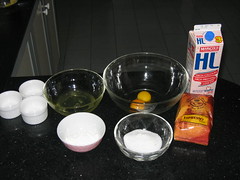
Notes on ingredients: The actual recipe is huge, so this proportional one involves some odd measurements. You may need 3 eggs if the ones you're using are small, though. Also, this recipe serves 3 if you're using 3-inch ramekins; if you're using 5-inch ones, it'll only serve 2.
Before starting your souffle, butter your ramekins and coat them with sieved icing sugar, knocking out the excess. This will help your soufflés rise straight without the need for a collar. I'll show you the results later. The prepared ramekins can now be cling-wrapped and placed in the fridge. If preparing your soufflés in advance, you should also measure out the 30g of sugar and 80g of egg whites (should be about two or three whites), storing them in the refrigerator in separate containers for later use, saving lots of time. Restaurant tip.
Now for the soufflé proper. It's going to sound complicated, but only because I'm trying to be as detailed as possible.
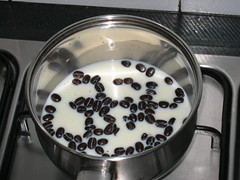
Boil your milk with the coffee beans, making sure the milk only just comes to a boil. Once that happens, turn off the fire and let the coffee beans infuse for a few minutes.
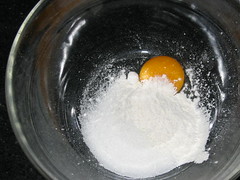
Add the 40g of sugar and flour to the egg yolks.
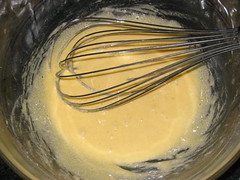
With a whisk, mix them till the mixture is pale and the ingredients are well incorporated.
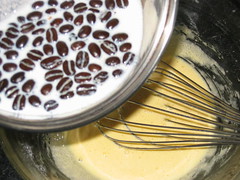
Your milk should have boiled by now, so strain the milk into your egg mixture. As you can see, I forgot to do this, so I spent five minutes picking coffee beans out of my sticky souffle base. Not fun.
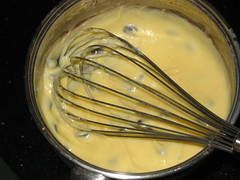
Pour the milk and egg mixture back into the saucepan, return it to the heat and stir till the mixture becomes yellow and thick, almost like porridge or dough, but without the coffee beans, of course.
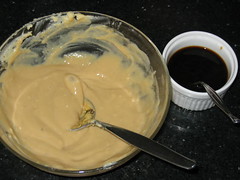
Dissolve one tablespoon of instant coffee in a little bit of water (you want the coffee strong), and add it gradually to your paste, until it turns a beige colour and smoothens to a thick, creamy paste. Now ideally you should cover this with a cartouche or some cling wrap to cool without producing any condensation, but if you're pressed for time you can proceed directly from here. This base can be stored for at least a few days, if you can keep it free from condensation. Any water would be bad for your soufflé.
Basically, 80g of your soufflé base, 80g of egg white and 30g of sugar will make three, or two, soufflés, depending on ramekin size. The amount of soufflé base you have is slightly over 160g, so you can make six soufflés, but you'll need 80g more egg white and 30g more sugar for the second batch, which leaves you extra yolks which you can use for more soufflé, and so on.
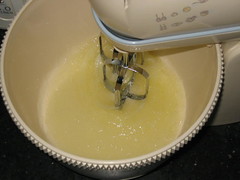
When it's time to prepare your soufflé, beat 80g of egg whites. If you're using the ones you prepared earlier and were waiting in the fridge, it would help if you took them out sooner to allow them to warm up to room temperature, but it's not crucial.
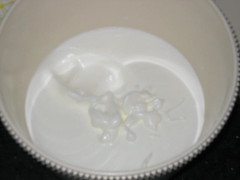
The beating of the whites is crucial to the success of your soufflé, so you'll want them as stiff as possible. The whites should resemble puffy clouds or marshmallows, sticking to the beaters when you're done whipping. Sometimes cheaper home beaters can't quite manage this, but try your best.
Cut a quarter of the beaten whites into your soufflé base and mix thoroughly with a spatula. Don't worry about deflating the whites because this is just to smoothen the mixture.
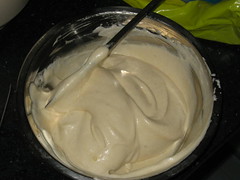
Cut the rest of the meringue, in batches, and fold into the soufflé base. Try not to be too violent, as this time you don't want the whites to deflate, but at the same time make sure they're well incorporated, otherwise you'll end up with pockets of egg white in your soufflé, which can be a bit nasty.
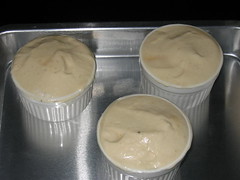
Scoop the mixture into the prepared ramekins and knock the base of the ramekins against the counter-top to let the mixture settle down and remove any air pockets. Using the spatula, skim away any excess mixture until the top is relatively flat, cleaning the sides as you go.
The soufflés are now ready to be baked and can be kept like this, refrigerated, for about fifteen minutes, after which they will not rise any more.
Now for the interesting part, the actual baking. At the restaurant, it only requires 6 minutes at 180°C and the soufflé is completely done. After 6 minutes in my oven, the soufflés only looked like this:
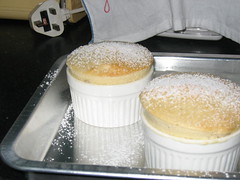
The tops had browned, but the soufflé hadn't risen by much. Not very satisfactory. I decided to try again, this time beating the whites more stiffly and leaving the soufflé in for close to 9 minutes, it came out like this:
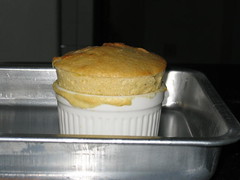
A better result in terms of height, but now the top was overcooked. I then decided to lower the oven temperature to 160°C and left the soufflé to bake for 15 minutes. The result:

An impressive height, though the top was a bit overcooked and the inside was somewhat dry as well. You can also see the bits of egg white that weren't mixed into the soufflé properly. Live and learn, I suppose. If you compare the two, the former was baked in a floured and sugared ramekin, while the latter wasn't, causing the dome shape and the rather pock-marked soufflé collar.
I wish I could give a more accurate instruction, but I suppose the choice is yours, 6 - 8 mins at 180°C or 10 - 12 mins at 160°C, depending on whether you prefer height or doneness. Sprinkle with icing sugar when you remove the soufflés from the oven, and serve at once, as they will deflate in a minute or two.
This entry is a little more convoluted and wishy-washy than I'd like it, but as I haven't quite perfected this recipe yet, I'm sure I'll make a few revisions as and when I tweak the process.
Technorati Tags: Recipes, Soufflé, Mocha Souffle
No comments:
Post a Comment